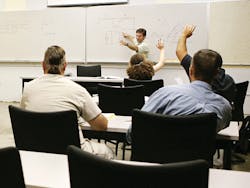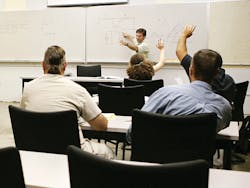If you’ve ever attended a Code class — and if you’re reading this article, there’s a good chance you have — it probably wasn’t the most exciting thing you’ve ever done. Dull, boring, and difficult to follow are some of the words that may come to mind, especially if the class format is a lecture-type environment. Unfortunately for the instructor, a lecture-type Code class frequently doesn’t reflect student faces that are attentive and smiling. So what can an instructor do to maintain students’ attention and foster a lively discussion?
Let’s use a basic NEC introductory class as an example. Many course lectures are based on learning objectives that explain the purpose and history of the Code, describe the layout of the Code book, and teach you how to navigate the various Articles and Sections of the document. This type of lecture only passively involves the student. They typically have no choice but to sit back and listen, which often leads to boredom and inattentiveness on their end.
So how can you better engage your students or employees? One idea is to prepare a number of questions related to the subject matter objectives and present those verbally to students throughout the duration of the class. This challenges each student to search, read, understand, decide, and engage with the instructor and classmates through the entire session. This method of class instruction is referred to as active learning, an approach that also works well where the classroom is divided into groups.
Active learning adapted to a Code class can fit into many leaning styles as well. Take, for example, three common learning styles for students in an adult Code class: a verbal style, preferring words in speech and in writing; a visual style, preferring the use of pictures and images; and an aural style, preferring the use of oral questions. One common opinion among building trade instructors is that most students prefer and better retain knowledge presented in both a visual and aural manner.
The topics in the Code are conducive to an active learning setting. They fit well with our three most common learning styles. And students often prefer learning activities orally presented where the instructor regularly asks students to engage with them via a verbal question-and-answer type exchange. Another learning tool is to create games between teams, where students compete against each other via groups or various table activities.
Two of the more common active learning visual activities involve using the NEC Table of Contents and Section 90.3 (including Figure 90.3). Lesson plans for these subjects are easily prepared around many quick and simple oral questions that require the student to name the specific Article (and perhaps even include the Part) based on many different related queries. Students typically progress rapidly through both of these subjects and, by using oral questions as class activities, the average student appears to show more confidence than students who don’t engage in this type of learning technique.
Moreover, many Code instructors agree that when the students are more active and engaged in the learning process, the subject matter is better understood and much more palatable and interesting for the student. Better yet, more than a few instructors agree that active learning techniques improve the pass rate generally expected on standardized electrician licensing examinations.
Sheehan is a curriculum specialist with the Electrical Training ALLIANCE based in Upper Marlboro, Md. He can be reached at [email protected].

